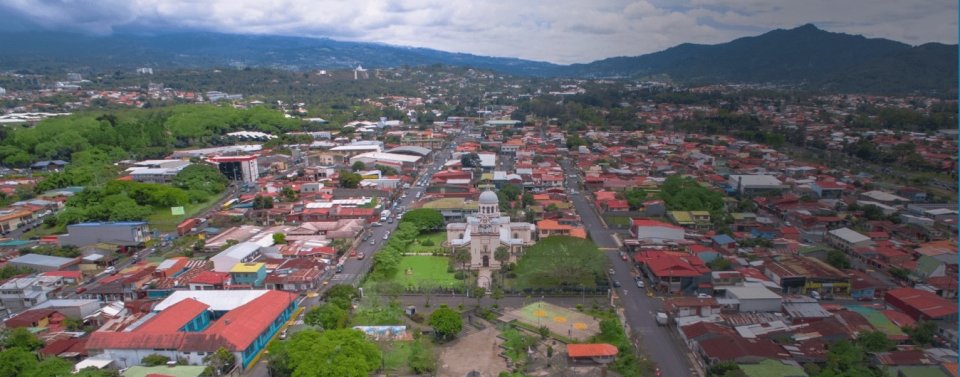
The city of Curridabat is located within the Greater Metropolitan Area (GAM), that is the main conurbation of the country with an extension of 2,044 km2, including 31 cities (municipalities) divided in 164 districts where 53% of the population of the Costa Rica reside. Curridabat covered an area of 15.95 km2 (all urban) and a population of 77,028 inhabitants in 2016. The city of Curridabat, located at the east of the GAM, along with many other cities in the Latin America, is now facing climate change and biodiversity loss due to global challenges and local pressures, including rapid urbanization and densification processes; the same as environmental, social and ecological conflicts. For the purpose of tackling these problems, the municipality has created the “Sweet City” program, based unintentionally in NbS.
Sweet City aims to create the conditions required to improve the quality of life of all the inhabitants of the territory, humans and other species alike, e.g. pollinators, by providing better conditions for them to thrive and, as a result, obtaining a more biodiverse, comfortable, clean, colorful and better organised urban environment. The aim is to restore the balance between urban and natural areas, preserve and increase biodiversity in the city and manage climate change.
The Sweet City program works with the existing resources; multidisciplinary teams, with participatory processes with communities, work together to design and implement using heir knowledge of the city (see figure 3). So far, ten strategies have been implemented: ‘water drop’, for the awareness of water use; ‘earthworm’, for better waste disposal (compost and soil regeneration); ‘sap’, for having areas to grow fresh vegetables and provide public access to them in order to encourage a more conscious approach to eating and food; ‘mariola’ (native plant), for creating safe and accessible paths prioritizing vulnerable populations; ‘ants’, for peaceful neighborhoods and social interactions; ‘hive’, for confidence in the inhabited place; ‘neuron’, for the prevention of mentalhealth issues in the population; ‘guide birds’, to improve the attention given to citizens by the municipality; ‘hummingbird’, for joyful physical exercise; and ‘güitite’ (native tree), for a better relationship with nature -this last strategy has become the main goal of the program.
Sweet City mainly proposes to eliminate the historical conflict that has existed between the city and nature through the preservation of biodiversity. This programme has as a relevant policy precedent in the Urban Regulatory Plan in 2013 which altered land use in Curridabat from segregated land uses and introduced mixed land use and the densification of transects. The previous approach to zoned land uses was implemented as an urban planning tool that designates the urban areas based on their physical characteristics and their relationship with the environment; different to zones that defines uses.
Potential benefits will be to:
- Increase Biodiversity.
- Increase quality and quantity of green and blue infrastructures.
- Increase achievements of biodiversity targets.
- Improve air quality.
- Increase amount of green open spaces for residents.
- Changing image of the urban environment.
- Increase communities’ sense of ownership.
- Developing climate change adaptation; improving risk management and resilience
- Restoring ecosystems and their functions
- Enhancing sustainable urbanisation
The Sweet City program is inspired by pollination and aims to be a role model for small and medium-sized cities around the world. It deals with a series of situations or “ways of doing things” where the traditional urbanization model is in conflict with the processes of nature. The program constitutes the local version of what is globally known as the Biophilic City, implemented in other cities aound the world. It begins with the establishment of urban green networks, which aim to re-establish the urban ecological functioning of green areas, parks and urban corridors through ecological design. This is done to bring a better environment for the people, and a better relationship with nature, instead of “optimizing” resources, as a traditional “green” approach would do.
To enable a participatory appraoch, a communication strategy was prepared in order to explain how the program would benefit everybody. This included diagrams and graphic aids, metaphor names and used non-technical language. Since the implementation of the program, that began with raising awareness about the importance of pollination for the environment, officials now believe that it is a vision of development and a city model, because at the end of the day, the program seeks to give a more satisfying life for the inhabitants.
Municipality of Curridabat.
Isaac Salgado-Ramírez
Pontificia Universidad Javeriana
Bogota, Colombia
Irene García and Huberth Mendez
Curridabat Mayor’s Office.
Further information
- 3. Good Health and Well-being
- 11. Sustainable Cities and Communities
- 13. Climate Action



